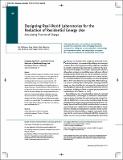Designing real-world laboratories for the reduction of residential energy use: Articulating theories of change
Date
2018-01-01Author
Heiskanen, Eva
Laakso, Senja
Matschoss, Kaisa
Backhaus, Julia
Goggins, Gary
Vadovics, Edina
Metadata
Show full item recordUsage
This item's downloads: 799 (view details)
Cited 23 times in Scopus (view citations)
Recommended Citation
Heiskanen, E., Laakso, S., Matschoss, K., Backhaus, J., Goggins, G., & Vadovics, E. (2018). Designing Real-World Laboratories for the Reduction of Residential Energy Use: Articulating Theories of Change. GAIA - Ecological Perspectives for Science and Society, 27(1), 60-67. doi: 10.14512/gaia.27.S1.13
Published Version
Abstract
Reducing residential energy use and carbon dioxide emissions is a policy concern across Europe. One of the approaches to address this problem, real-world laboratories (RwLs), has recently gained prominence as a means to generate both sustainability change and social knowledge. Yet RwLs are context-bound, and transferability is an issue for scaling up change. Drawing on Realistic Evaluation (RE) and Theories of Change (ToC), this paper analyses researchers and practitioners views on the role of contexts and change mechanisms in the outcomes of interventions targeting residential energy use.
The results show that extracting the underlying logic of RwL designs could help to identify where and when these designs are likely to be transferrable. This contribution has implications for the design of future RwLs, given that RwLs have until now rarely articulated their ToC.


